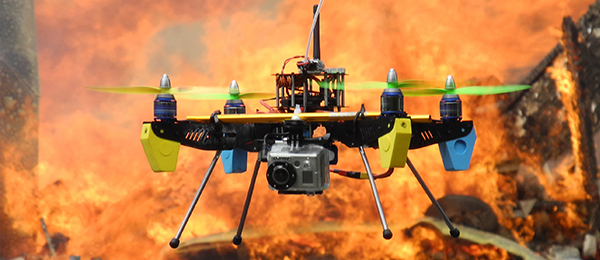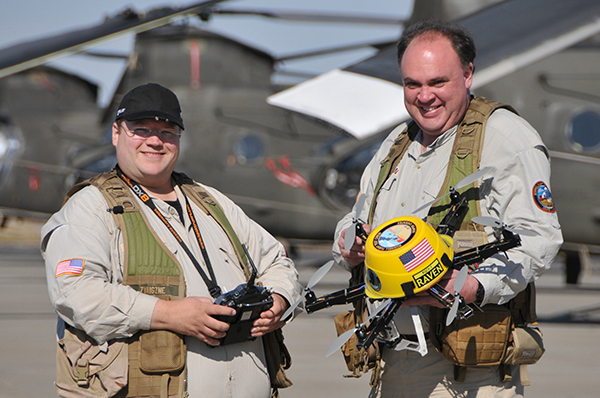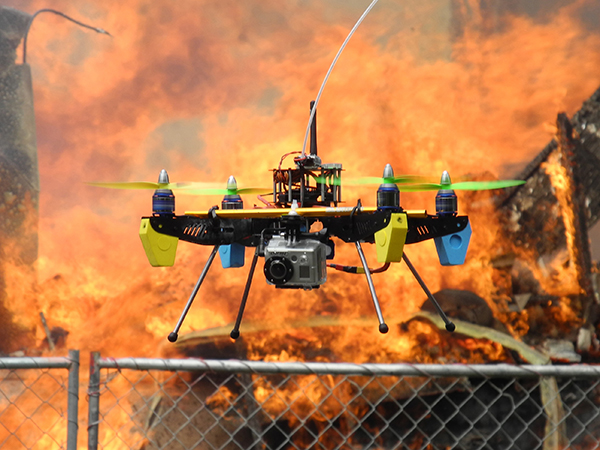Advanced Flight Technologies - January 2014

Written by Patrick Sherman Safety and new technology Read the entire article in the January 2014 issue of Model Aviation.
On July 1, 1947, a vehicle, not of this Earth, crashed outside the unassuming town of Roswell, New Mexico—or so it is said. Contrary to the rumors you may have read online, we weren’t actually aboard that craft, but we do feel a certain kinship with its occupants. You see, we are aliens—not to this planet, but to the hobby of model aeronautics. Some of you may see us as hostile or even dangerous, but I assure you that we come in peace, and we very much would like to be your friends. What makes us alien? Well, we fly multirotors equipped with First-Person View (FPV) systems. Three years ago, when we were getting our start, only a few people in the model aviation community had ever even heard of either FPV or multirotors. That’s actually where the “Roswell Flight Test Crew” gets its name. Whenever we would fly in public, people would take one look at our machines and call out with a laugh, “Look, it’s a UFO!” Like most novice RC pilots, we crashed—a lot—so taking our name from the most famous UFO crash in history seemed to make sense.
 The Roswell Flight Test Crew’s logo pays fanciful tribute to its mythical forebearers—the alien beings who allegedly crashed near Roswell NM in 1947. The crew’s Latin motto, Semper Cadentes, is translated into English as Always Crashing.
The Roswell Flight Test Crew’s logo pays fanciful tribute to its mythical forebearers—the alien beings who allegedly crashed near Roswell NM in 1947. The crew’s Latin motto, Semper Cadentes, is translated into English as Always Crashing.
Like pod people, multirotors and FPV gear are appearing everywhere, even in the pages of MA magazine! For some, this is an unwelcome development. They see FPV as a threat to the entire hobby, bringing unwelcome scrutiny from the FAA and in state legislatures, bad publicity in the news media, and embroiling the hobby in the ongoing debate over drones. We understand and appreciate these concerns. No one is more upset than we are when someone does something stupid with an FPV system, and there have been plenty of instances in the past year. That irresponsible behavior needs to stop, and the only way to stop it is by educating the members of the FPV community about how to fly safely. There is an organization that has been doing that for 78 years: the Academy of Model Aeronautics. Those of us who fly FPV have generally come to the hobby by an unconventional route. We didn’t get started at the local hobby shop or at an AMA flying field. We ordered some parts off of the Internet and we’ve been making it up as we go. Not very smart, as we’ll be the first to admit (it’s enough to make you wonder what’s inside those giant, gray craniums) but, we’d never heard of the AMA before. We certainly didn’t want to hurt anyone or do anything reckless. We just wanted to do cool stuff similar to those we saw on the Internet buzzing around New York City. We figured out that this isn’t the way to do business, thanks to the AMA. When we joined the organization more than two years ago, we discovered that we are part of a much larger community that puts a priority on safe, responsible flight operations.
 Pictured with their flagship FPV hexacopter, the RQCX-3 Raven, Brian Zvaigzne and Patrick Sherman, known as Techinstein and Lucidity, established the Roswell Flight Test Crew three years ago to explore the potential benefits of flying FPV.
Pictured with their flagship FPV hexacopter, the RQCX-3 Raven, Brian Zvaigzne and Patrick Sherman, known as Techinstein and Lucidity, established the Roswell Flight Test Crew three years ago to explore the potential benefits of flying FPV.
Although I’m sure that you could find a few FPV fliers who would disagree, the truth is that the FPV community urgently needs the AMA, and everything that it brings with it: national representation, liability insurance, operating standards, and a long, proud history in which we are only the most recent participants. We’ve arrived on the AMA’s doorstep with a pair of video goggles and a taste for adventure. There is plenty that we need and want, but what do we have to offer in return? That’s a fair question, and the answer comes in three parts.
An Awesome Ride
Assuming that you’re among the skeptics who have never before flown FPV, come out to the field with me and strap on these opaque, plastic goggles. In two minutes I will alter your perception of the hobby and when you get home afterward, you will be online, typing “wireless video transmitter” into Google. I enjoy it myself, but beyond that, I’ve had the opportunity to see the expressions on hundreds of people’s faces when they try on the goggles for the first time, and the reaction is slack-jawed wonder spiked with a straight-up shot of pure joy. If you’re a skeptic, find someone who knows what he or she is doing and give it a try. If you do that and you still want to argue with me about how FPV is ruining the hobby, I will patiently listen. I promise.New Blood
It’s no secret that during the past several years, the AMA has faced stagnant or declining membership numbers and the average age of its members has increased. Shifting demographics have wiped out many institutions that were once pillars of the community, such as the service organizations of our parents’ and grandparents’ generations. When was the last time you saw a grown man driving a tiny car while wearing a fez? I thought so ... The advent of multirotors and FPV flying is pulling new people into the hobby at a rate that hasn’t been seen since, well, maybe never. Do they share the current membership’s love of Scale warbirds and hand-built models? Not necessarily, but they do share something even more important and fundamental: a genuine passion for flying and a restless curiosity to see what is actually possible with plastic and fiberglass and modeling plywood and dreams.Unprecedented Relevance
Not since the AMA was founded, with the goal of helping children master the fundamentals of aeronautics to prepare them for careers in the burgeoning aviation industry—all to the tune of “Up in the Air, Junior Birdmen!”—has model aeronautics had the opportunity to make such an impact on society. Through a Kafkaesque failure of government regulation (which has grounded the professionals until at least 2015, while leaving the skies wide open for hobbyists), it has been left to all of us to chart the promise and the perils of this new technology. That is the Roswell Flight Test Crew’s mission: to show how this technology can safely be used to solve real-world problems. We’ve had the opportunity to fly demonstration missions with fire departments and look at a range of scenarios from hazardous material spills, to search and rescue, to wildfires and structural firefighting. We’ve also worked with scientists to explore the possibility of using FPV multirotors to look at localized variations in river temperatures to help them restore native fish habitats. The only limit to the potential of this technology is our own imagination. One of the primary missions of the Roswell Flight Test Crew has been to demonstrate the potential use of FPV multitrotors in public safety operations. An early design, the RQCX-2 Galaxian, hovers near a structural fire deliberately ignited as part of a firefighting exercise.
One of the primary missions of the Roswell Flight Test Crew has been to demonstrate the potential use of FPV multitrotors in public safety operations. An early design, the RQCX-2 Galaxian, hovers near a structural fire deliberately ignited as part of a firefighting exercise.
So, more than anything, we hope that you’ll join us. We need you—we need your experience, your support, and your ideas. We even have a project to get you started. Last October, our friends at the Drone User Group Network announced the first “Drone Social Impact Award.” A $5,000 prize will be given to the individual or team that uses a hobby drone costing less than $3,000 to best help address a problem or concern in their community. Entries are due by March 10, 2014. For complete information about the contest’s rules and how you can submit a project, visit the Drone User Group Network’s website at www.dugn.org/prizes.










2 comments
exciting
FPV
Add new comment